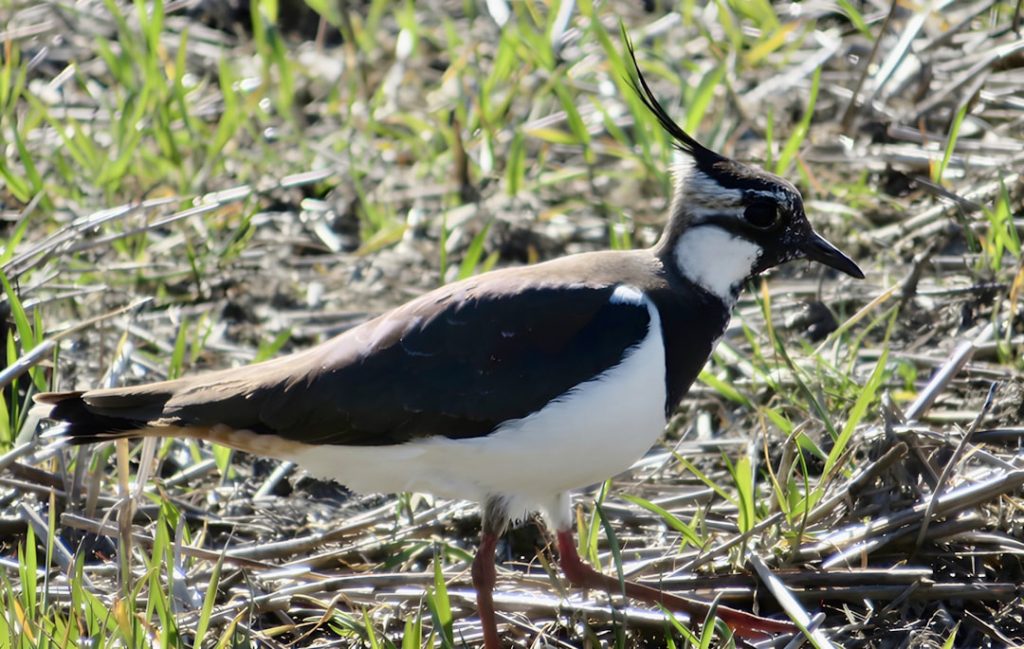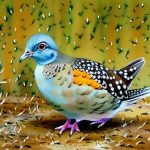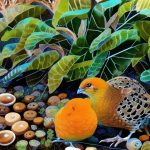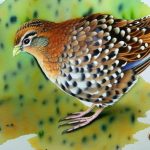Button quail, also known as Chinese painted quail, are small, ground-dwelling birds that are native to Southeast Asia. They are popular among aviculturists for their small size, colorful plumage, and interesting behaviors. Button quail are often kept as pets or for breeding purposes, and they can be a rewarding addition to any aviary or bird collection.
Button quail are known for their small size, with adults typically reaching only 4-5 inches in length. They come in a variety of colors, including silver, cinnamon, and pearl, and their intricate patterns make them a visually appealing species to keep. In addition to their attractive appearance, button quail are also known for their interesting behaviors, such as dust bathing and foraging for insects. These birds are social creatures and are often kept in small groups or pairs to ensure their well-being.
Button quail are relatively easy to care for and can be kept in a variety of enclosures, including aviaries, cages, or even large terrariums. They are ground-dwelling birds, so it’s important to provide them with plenty of space to roam and forage. Additionally, button quail are known for their ability to fly short distances, so it’s important to provide them with a secure enclosure to prevent escape. Overall, button quail are a fascinating and low-maintenance species that can bring joy to bird enthusiasts of all levels.
Table of Contents
Key Takeaways
- Button quail are small, ground-dwelling birds that make interesting and low-maintenance pets.
- Breeding button quail requires a balanced diet, proper nesting materials, and a suitable environment.
- Genetic considerations in breeding button quail include understanding color mutations and genetic diseases.
- Care and maintenance of button quail involves providing a clean and spacious living environment with proper temperature and humidity levels.
- Health considerations for button quail include regular check-ups, parasite prevention, and a balanced diet to prevent common health issues.
Breeding button quail can be a rewarding experience for aviculturists, as these birds are relatively easy to breed and can produce multiple clutches of eggs throughout the breeding season. When breeding button quail, it’s important to provide them with a suitable nesting area and a balanced diet to ensure successful reproduction.
Button quail reach sexual maturity at around 6-8 weeks of age, and breeding pairs will often display courtship behaviors such as calling, preening, and chasing. Once a pair has formed, it’s important to provide them with a suitable nesting area, such as a shallow dish filled with sand or peat moss. Button quail will often lay their eggs in these materials, and it’s important to provide them with privacy and security during the breeding process.
In terms of diet, breeding button quail should be provided with a high-quality game bird feed supplemented with fresh fruits and vegetables. It’s important to ensure that breeding pairs are receiving adequate nutrition to support egg production and chick rearing. Additionally, providing a calcium supplement such as crushed oyster shell can help prevent egg binding and ensure the health of the breeding pair.
Overall, breeding button quail can be a fascinating and rewarding experience for aviculturists of all levels. By providing suitable nesting areas and a balanced diet, breeders can enjoy the sight of these small birds raising their own young and contributing to the conservation of this unique species.
When breeding button quail, it’s important to consider the genetic implications of pairing different color variations and patterns. Button quail come in a variety of colors, including silver, cinnamon, pearl, and white, and breeders often work to produce specific color variations through selective breeding.
In order to produce specific color variations in button quail offspring, breeders must understand the basics of genetics and inheritance patterns. For example, the silver color variation in button quail is a dominant trait, meaning that if a bird carries the silver gene (S), it will display the silver phenotype. On the other hand, the pearl color variation is recessive, meaning that both parents must carry the pearl gene (pp) in order to produce pearl offspring.
By understanding these genetic principles, breeders can selectively pair birds with specific color variations to produce offspring with desired traits. Additionally, breeders must be mindful of inbreeding and genetic diversity when working with button quail populations. Inbreeding can lead to an increased risk of genetic disorders and reduced fertility, so it’s important to introduce new genetic material into breeding programs to maintain healthy and diverse populations.
Overall, genetic considerations play a crucial role in button quail breeding programs, and breeders must have a solid understanding of inheritance patterns and genetic diversity to produce healthy and desirable offspring.
The care and maintenance of button quail is relatively straightforward, but it’s important to provide these birds with a suitable environment and balanced diet to ensure their well-being. When keeping button quail, it’s important to provide them with a spacious enclosure that allows for natural behaviors such as foraging and dust bathing.
Button quail are ground-dwelling birds that require plenty of space to roam and explore. A suitable enclosure for button quail should include a substrate such as sand or peat moss for dust bathing, as well as hiding spots and perches for enrichment. Additionally, it’s important to provide button quail with access to fresh water and a balanced diet consisting of game bird feed supplemented with fresh fruits and vegetables.
In terms of socialization, button quail are social creatures that thrive in small groups or pairs. It’s important to provide them with suitable companionship to prevent loneliness and ensure their well-being. Additionally, providing environmental enrichment such as live plants or foraging toys can help keep button quail mentally stimulated and engaged.
Overall, the care and maintenance of button quail is relatively simple but requires attention to detail in terms of enclosure setup, diet, and socialization. By providing these small birds with a suitable environment and balanced nutrition, aviculturists can enjoy the sight of healthy and thriving button quail in their care.
Button quail are generally hardy birds that are relatively resistant to common avian diseases. However, it’s important for aviculturists to be mindful of potential health issues and provide proper care to prevent illness in their button quail populations.
One common health concern in button quail is obesity, which can result from overfeeding or providing a diet that is too high in fat content. It’s important to monitor the body condition of button quail and provide them with a balanced diet to prevent obesity-related health issues such as fatty liver disease.
Additionally, button quail are susceptible to external parasites such as mites and lice, which can cause irritation and discomfort for the birds. Regular inspection of button quail for signs of parasites is important, and aviculturists should be prepared to treat infestations promptly to prevent further spread within the population.
Another health consideration for button quail is respiratory infections, which can be caused by poor air quality or exposure to drafts. It’s important to provide button quail with a clean and well-ventilated environment to prevent respiratory issues, as well as regular cleaning of the enclosure to remove waste and debris.
Overall, maintaining the health of button quail requires attention to detail in terms of diet, parasite control, and environmental conditions. By providing proper care and monitoring for signs of illness, aviculturists can ensure the well-being of their button quail populations.
Selecting Breeding Stock

When selecting breeding stock for button quail breeding programs, it’s important to consider factors such as genetic diversity, physical traits, and behavioral characteristics. By carefully selecting breeding stock, aviculturists can work towards producing healthy offspring with desirable traits.
One important consideration when selecting breeding stock is genetic diversity. Inbreeding can lead to an increased risk of genetic disorders and reduced fertility in offspring, so it’s important to introduce new genetic material into breeding programs on a regular basis. By selecting unrelated individuals for breeding pairs, aviculturists can help maintain healthy and diverse populations of button quail.
In addition to genetic diversity, physical traits such as color variations and patterns should also be considered when selecting breeding stock. Breeders may have specific goals in mind for producing certain color variations or patterns in offspring, so it’s important to select individuals that carry the desired traits.
Behavioral characteristics should also be taken into account when selecting breeding stock for button quail. Birds that display strong courtship behaviors and successful reproductive histories may be preferred for breeding programs, as they are more likely to contribute to successful reproduction in captivity.
Overall, selecting breeding stock for button quail breeding programs requires careful consideration of genetic diversity, physical traits, and behavioral characteristics. By choosing individuals that contribute to healthy populations and desirable offspring traits, aviculturists can work towards successful breeding programs for this unique species.
In conclusion, button quail are fascinating birds that can be a rewarding addition to any aviary or bird collection. Their small size, colorful plumage, and interesting behaviors make them an attractive species for aviculturists of all levels. By providing suitable care and attention to genetic considerations in breeding programs, aviculturists can enjoy the sight of healthy and thriving button quail populations.
For those interested in learning more about button quail care and breeding, there are several resources available that provide valuable information on these topics. Books such as “The Button Quail” by Rosemary Lowe offer comprehensive guides to caring for button quail in captivity, including information on housing, diet, breeding, and health considerations. Additionally, online forums and communities dedicated to aviculture can provide valuable insights from experienced breeders and enthusiasts who have worked with button quail.
Overall, button quail are an intriguing species that offer unique opportunities for aviculture and breeding programs. By providing proper care and attention to genetic considerations, aviculturists can enjoy the company of these small but captivating birds in their care.
If you’re interested in learning more about the care, breeding, and genetics of button quail, you might also want to check out this informative article on creating a garden chicken coop. It offers valuable insights into creating a suitable environment for poultry, which can be applied to button quail as well. Understanding the importance of a well-designed living space is crucial for the health and well-being of any bird species.
FAQs
The button quail, also known as the Chinese painted quail, is a small ground-dwelling bird native to Southeast Asia and the Indian subcontinent. They are popular as pets and are also bred for their unique and colorful plumage.
Button quail require a suitable enclosure with plenty of space to move around, as well as a balanced diet of seeds, insects, and greens. They also need access to clean water for drinking and bathing. Proper temperature and humidity levels are important for their well-being.
Breeding button quail requires a suitable nesting area with soft bedding material. The birds should be provided with a balanced diet and a stress-free environment to encourage breeding behavior. It’s important to monitor the breeding pair closely and provide proper care for the eggs and chicks.
Button quail come in a variety of color mutations, including silver, cinnamon, and pearl. These color variations are the result of genetic traits passed down from the parents. Breeders often select for specific color traits to produce desired offspring.
Meet Walter, the feathered-friend fanatic of Florida! Nestled in the sunshine state, Walter struts through life with his feathered companions, clucking his way to happiness. With a coop that’s fancier than a five-star hotel, he’s the Don Juan of the chicken world. When he’s not teaching his hens to do the cha-cha, you’ll find him in a heated debate with his prized rooster, Sir Clucks-a-Lot. Walter’s poultry passion is no yolk; he’s the sunny-side-up guy you never knew you needed in your flock of friends!







